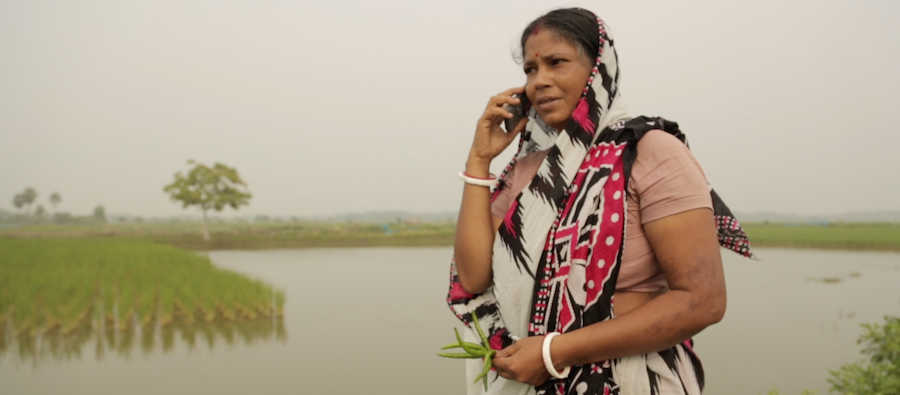J. Nicolas Hernandez-Aguilera, Postdoctoral Research Scientist at the International Research Institute for Climate and Society (IRI)J. Nicolas Hernandez-Aguilera explores how digital tools can empower farmers in developing countries with information and support, and the role that researchers, governments and the private sector can play in bridging digital divides.
The digital age of farming is within reach.
Among the poorest 20 per cent in low and middle-income countries, 70 per cent of people have access to a mobile phone and one in three have internet access. And although connectivity still prevails in urban settings around the globe, it is continuing to spread to rural areas.
This is especially helpful for smallholder farmers, as the ratio of farmers to extension workers in these areas often exceeds 1,000 to one. Using digital tools could help to reach more than 170 million small-scale farmers around the world, empowering them with better knowledge and information to help them make decisions. And this connectivity within agricultural networks is only set to keep growing.
When implemented effectively, digital tools can provide a two-way street between farmers and agricultural specialists – enabling climate and agriculture researchers to generate, transfer and translate climate and agricultural information from farmers, and share it with them through better advisory services.
A long road ahead
The use of digital tools in agriculture is still lower than in other sectors, which reveals great opportunity, but also limitations for scalability. Indeed, while sharing information through digital tools costs close to nothing, there are fixed system development costs that make it difficult to reach a larger number of farmers.
On the one hand, farmers are often either not willing or do not have the means to pay extra for digital services. Private firms, on the other hand, might be willing to cover the costs, but then tailor advice based on their own interests. These commercial barriers suggest that public financing could be one way to cover fixed costs and enable digital tools to be developed.
Public-private partnerships could be a crucial part of the solution in the road ahead. For instance, Esoko – a private digital company working in Ghana – has demonstrated a workable model, basing its activities on partnerships with national and international research agencies, the national meteorological agency, private weather service providers and mobile network providers.

Mobile phones are being used in India to share climate advice with farmers.
Photo credit: Jacquelyn Turner (IRI/CCAFS)
Special attention to inclusiveness
There is also the risk that, if not well implemented, digital tools can actually increase gaps in information access. Prioritising inclusivity is therefore essential, to ensure that the digital tool revolution in agriculture reaches all farmers.
There is still a significant digital divide in terms of internet access and literacy, for instance, while phone owners tend to be wealthier, better educated and predominantly male. To bridge these gaps, financial support should not be limited to additional capital, but should also encompass targeted investments to reach excluded populations, with policies guaranteeing low-cost data access in rural areas.
Researchers can also play a key role in this, by identifying cultural and behavioural barriers and customising digital tools to suit farmers’ specific needs and circumstances.
In India, for example, researchers from the International Maize and Wheat Improvement Center (CIMMYT) showed how sharing climate advice through mobile phones could reduce the knowledge gap between large and small farmers, and also across gender, by creating awareness about new technologies and best practices. By understanding the different information needs of women and men farmers – and then targeting those information needs through SMS – they found that the listening rate of women farmers matched that of men farmers, and that women felt empowered by the information they received.
The way forward
As well as the fixed costs and lack of investments that limit the reach of digital tools in agriculture, there are gaps and restrictions that are not always evident. Research centres can help by providing a universal framework for evaluating and standardising digital tools, and consolidating a systematic review process to inform governments and the private sector about gaps and investment opportunities.
Along with hundreds of partners, the Global Commission on Adaptation is currently developing a blueprint for investment in climate-informed digital advisories, drawing out lessons and principles on best practice to reach hundreds of millions of farmers.
Overall, more transparency in digital tool development within agriculture will increase trust, relevance and inclusivity for farmers, researchers and practitioners alike. With approximately 500 million small-scale agricultural producers, and many facing intensifying climate impacts, digital tools present much promise in helping them to adapt at scale.
Ana Maria Loboguerrero, Head of Global Policy Research of the CGIAR Research Program on Climate Change, Agriculture and Food Security (CCAFS) and Climate Action Research Director of the Alliance of Bioversity International and the International Center for Tropical Agriculture (CIAT), Alexandra Herrera, Research Assistant at the Earth Institute, Columbia University, and Walter Baethgen, Director of the Regional and Sectorial Research Program and leader for Latin America and the Caribbean in the IRI at the Earth Institute, also contributed to this article.



